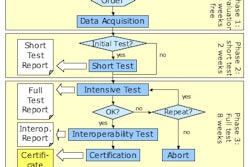Every healthcare facility in the world wants its information technology to be brand new, state-of-the-art, successfully tested, and operating without a glitch in at least 150 other institutions.
Complicating a new IT purchase is the finite amount of dollars in a given medical center's budget, and not every healthcare provider is sure that it wants to be the first institution to have the latest IT software, in part, for fear that all the bugs have not been eradicated.
IT has become an important tool in campaigns to reduce medical errors and improve patient care and safety. While some providers see IT as a godsend, others perceive it simply as a necessary evil. The latter group is among the providers who need to be assured of tangible benefits from any IT capital expenditure.
"Most institutions that are contemplating a particular IT investment are doing so in a competitive environment. There are other people (within the institution) who want that capital, too," said James Oakes, principal at Healthcare Information Consultants, an IT investment consultant firm in Baltimore. "The more you do your homework and the more you are able to show projected savings and calculations to the value of that technology, the more likely the technology will be funded and the more likely the technology will be rolled out."
Slow IT adoption
Successful implementations of fully automated IT systems, such as electronic medical records, are "still pretty rare" in healthcare, Oakes said. For example, a study from the Orem, UT-based research firm KLAS noted that less than 4% of hospitals in the U.S. use computerized physician order entry (CPOE) technology. Most of the caregivers that do have CPOE systems are academic medical centers.
"We are all moving toward fully electronic records, but we are not there yet," Oakes added. "We need to understand that failure can cost you your job, but, on the other hand, failure to act can cost you your job."
Speaking at this year's annual meeting of the Society for Imaging Informatics in Medicine (SIIM) in Providence, RI, Oakes outlined the due diligence process healthcare facilities should consider before making a major IT commitment and investing precious dollars in a technology that might not be right for them.
The first option always is to do nothing at all. A facility can redesign its clinical processes to enhance workflow efficiencies, for example, without any new IT investment. "You can re-engineer a system or you can look at buying a system," he said. "The more you go through the process of understanding what the choices are, the easier it will be for someone to follow your logic and calculations."
Speaking IT
Each person -- whether a clinician, technologist, or chief financial officer -- perceives IT differently. When making a pitch for an IT project, know which issues are important to each person.
Oakes cited the Healthcare Information and Management Systems Society (HIMSS) 2007 Leadership Survey, which found that reducing medical errors and improving safety were the top priorities among healthcare IT staff. Also on the list were replacing clinical systems and implementing electronic medical record technology. A paper from the American College of Healthcare Executives found that financial challenges and physician-hospital relations were top priorities for hospital management.
Target the pitch toward those priorities, and "talk about the benefits in the context of the listener," he said.
Return on investment
Return on investment (ROI) is one key component to justifying an IT commitment. Healthcare's traditional focus on ROI has been with operational savings -- the dollars and cents that are quantified, for example, when a hospital buys a PACS and saves on the cost of paper, film, and chemicals.
Upfront, one-time direct costs include hardware, software, training, and first-year maintenance of the technology. By calculating those factors, an institution can estimate initial costs and compare them with cash flow, both year by year and cumulatively.
"We are then able to show the net present value and rate of return," Oakes said. "This gives us enough good information to understand why we invested in the technology, what we expected to get out of it, and how we (can) monitor that expectation over the life of a project to see if we were achieving it or not."
Additional benefits come when the technology allows for the redesign of processes across departments and results in improved scheduling capabilities and maximization of caregivers' time, to name a few positives. Those intangibles may be more difficult to quantify, Oakes said, but they can be more meaningful to staff and patients in the long term than the initial financial investment.
Life cycle management
While healthcare organizations are getting better about planning for the acquisition and implementation of IT, few providers plan for success throughout the technology's life cycle. One key is having the right people in place to manage and maintain the project.
"When you look back and find that a project has not given the benefits you hoped for, the reason is almost always tied up in governance of the project," Oakes said. "Good governance will not guarantee a successful outcome, but poor governance will almost certainly doom the project."
Successful projects also are accomplished because healthcare facilities have -- as Oakes describes them -- "individual heroes," people who work extraordinarily hard to guide a project carefully and meticulously to its completion one step at a time.
"It is not the kind of thing you can do by next Tuesday," he emphasized. "It becomes a process and way of living with technology that you have to build over time."
By Wayne Forrest
AuntMinnie.com staff writer
September 27, 2007
Related Reading
Making speech recognition work -- the Shields experience, August 10, 2007
Electronic medical record system quickly returns investment at academic center, July 19, 2007
Meticulous planning, constant testing ensure optimum IT system uptime, July 12, 2007
Patience pays off with voice recognition implementation, July 6, 2007
Multitier staffing model optimizes imaging IT support capabilities, June 9, 2007
Copyright © 2007 AuntMinnie.com



















